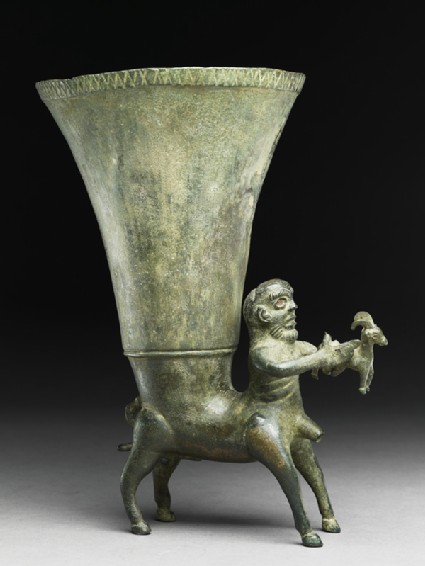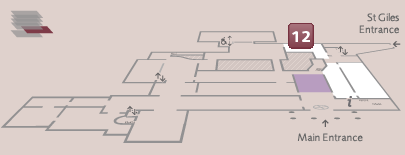Browse: 1 object
- Reference URL
Actions
Rhyton in the form of a centaur
-
Details
- Associated place
-
Asia › Pakistan › Ishkuman Valley › Imit (find spot)
- Date
- 3rd - 2nd century BC (300 - 101 BC)
- Material and technique
- bronze, solid cast
- Dimensions
- 26.9 x 21 x 16 cm max. (height x width x depth)
- Material index
-
processed material › metal › alloy › copper alloy › bronze
- Technique index
- Object type index
-
container › vessel › drinking-vessel › drinking-cup › rhyton,container › vessel › cup › drinking-cup › rhyton,
- No. of items
- 1
- Credit line
- Presented by the Estate of Sir Aurel Stein, 1963.
- Accession no.
- EA1963.28
-
Further reading
Harle, J. C., and Andrew Topsfield, Indian Art in the Ashmolean Museum (Oxford: Ashmolean Museum, 1987), no. 5 on pp. 5-6, p. 15, pl. 1 (colour) & p. 5
Boardman, John, The Diffusion of Classical Art in Antiquity, The A. W. Mellon Lectures in the Fine Arts (London: Thames and Hudson, 1994), 149, fig.4.95
Stein, Aurel, ‘Archaeological Notes from the Hindukush Region’, Journal of the Royal Asiatic Society of Great Britain and Ireland, 1/April, (April 1944), pp. 14-16, pl. III a
Cambridge: Fitzwilliam Museum, 6 October-13 December 1992, The Crossroads of Asia: Transformation in Image and Symbol in the Art of Ancient Afghanistan and Pakistan, Elizabeth Errington, Joe Cribb, and Maggie Claringbull, eds, 90 (Cambridge: Ancient India and Iran Trust, 1992), No.95
Vienna: Kunsthistorisches Museum, 2 April-16 July 1995, Buddha in Indien: Die frühindische Skulptur von König Asoka bis zur Guptazeit, Deborah E. Klimburg-Salter, ed. (Vienna: Kunsthistorisches Museum and Milan: Skira, 1995), no. 9 on p. 64, illus. p. 65 fig. 9
Salomon, Richard, ‘An Inscribed Silver Buddhist Reliquary of the Time of King Kharaosta and Prince Indravarman’, Journal of the American Oriental Society, 116/3, (1996), pp. 438-439, illus. p. 439 fig.23
Jettmar, Karl, ‘Rock Carvings and Stray Finds in the Mountains of North Pakistan: Archaeology before Excavation’, Maurizio Taddei, ed., South Asian Archaeology: Papers from the Fourth International Conference of the Association of South Asian Archaeologists in Western Europe, 2 vols, Series minor: Istituto universitario orientale, Seminario di studi asiatici, 6 (Naples: Istituto universitario orientale, 1979), ii, 917-926
Litvinsky, B. A., Copper Cauldrons from the Indian Subcontinent and Pamirs: The Ancient Connection of the Two Regions
Litvinskij, Boris A., ‘Copper Cauldrons from Gilgit and Central Asia. More about Saka and Dards and Related Problems’, East and West, 52/1-4, (2002), 127-149
Litvinskij, B.A., ‘Pamir und Gilgit, kulturhistorische Verbindungen’, ed. Karl Jettmar, Antiquities of Northern Pakistan: Reports and Studies, ii, 4 vols (Mainz: Verlag Philipp von Zabern, 1993), ii, 141-149
Location
Objects are sometimes moved to a different location. Our object location data is usually updated on a monthly basis. Contact the Jameel Study Centre if you are planning to visit the museum to see a particular object on display, or would like to arrange an appointment to see an object in our reserve collections.
Publications online
-

Indian Art in the Ashmolean Museum
This rhyton and a small bronze bowl or ladle with a projecting horse’s head ([EA1976.122], also transferred from the Dept. of Antiquities) are, with the exception of a copper hoard harpoon [EA1986.13] and axe-head, the oldest metal objects from the Indian subcontinent in the Museum. Discovered when a portion of hillside fell away, they are also exceptional in that their find-place is accurately documented.
The vigorously but rather crudely modelled solid cast figure of a bearded centaur derives from Graeco-Roman models. The small animal, an ibex, is held between the centaur’s hands by a pin centrally located through its body, allowing the little animal to remain horizontal while the rhyton is tilted by the drinker, who received his beverages through the centaur’s male organ. Animal rhytons, sometimes simply terminating in animals heads [see EA1962.42], can be traced back to Achaemenid times.
A recent metal analysis suggests that the two objects come from quite different cultures and, as part of a hoard, which seems highly likely, may have been made at a considerable distance in time from one another. The little bowl is almost exclusively copper; the rhyton is a leaded bronze of the type (although the lead content is very high) common in much of the ancient world in the centuries before and after the beginning of the era. There may, of course, have been other objects in the hoard, which were not turned over to the authorities, those in precious materials in particular.
A solid link has been established between the small bowl and graves in the Pamirs in Tadjikistan, U.S.S.R., of the late centuries B.C. Very similar, but entirely zoomorphic rhytons in terracotta, on the other hand have been found at sites in ancient Bactria, dating from Kusāna times. This tallies with the generally accepted assumption that the forms of metal wares subsequently gave rise to terracotta analogues, rather than vice-versa, and would tend to place the rhyton in the last two or three centuries B.C. It has further been suggested by Professor Jettmar (correspondence) that rather than being part of a local magnate’s treasure imported into Dardistan, the ancient name of the region where they were found, the Museum’s two objects were part of the ritual equipment of a tribe, the “Horse-people” of the ancient sources (Skt. Asvakayana, Grk. Assakenoi) who ruled over the mountains west of Tibet.
Galleries
© 2013 University of Oxford - Ashmolean Museum











